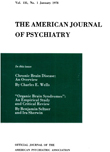MORAL INSANITY IN THE UNITED STATES 1835-1866
Abstract
Before the 1860s many leading American psychiatrists accepted the concept of moral insanity as defined by Prichard. These men also emphasized the psychological element in the etiology, pathology, and treatment of mental illness and were in advance of their colleagues on most psychiatric questions. They tried to take a purely clinical and scientific view of mental illness and to broaden its confines to include largely emotional disorders. Some psychiatrists, however, had reservations about the theory of moral insanity, and a few, like Gray, condemned it outright. Fear of public opinion, reluctance to take an independent stand on controversial issues, and attachment to conventional moral precepts, combined with an increasing stress on somaticism, led a growing number of American psychiatrists eventually to reject the concept of moral insanity. This trend reflected the passing of the first and more venturesome generation of the new profession. The problems that moral insanity dealt with and the controversy that it inspired, however, remain with us to this day.
Access content
To read the fulltext, please use one of the options below to sign in or purchase access.- Personal login
- Institutional Login
- Sign in via OpenAthens
- Register for access
-
Please login/register if you wish to pair your device and check access availability.
Not a subscriber?
PsychiatryOnline subscription options offer access to the DSM-5 library, books, journals, CME, and patient resources. This all-in-one virtual library provides psychiatrists and mental health professionals with key resources for diagnosis, treatment, research, and professional development.
Need more help? PsychiatryOnline Customer Service may be reached by emailing [email protected] or by calling 800-368-5777 (in the U.S.) or 703-907-7322 (outside the U.S.).



